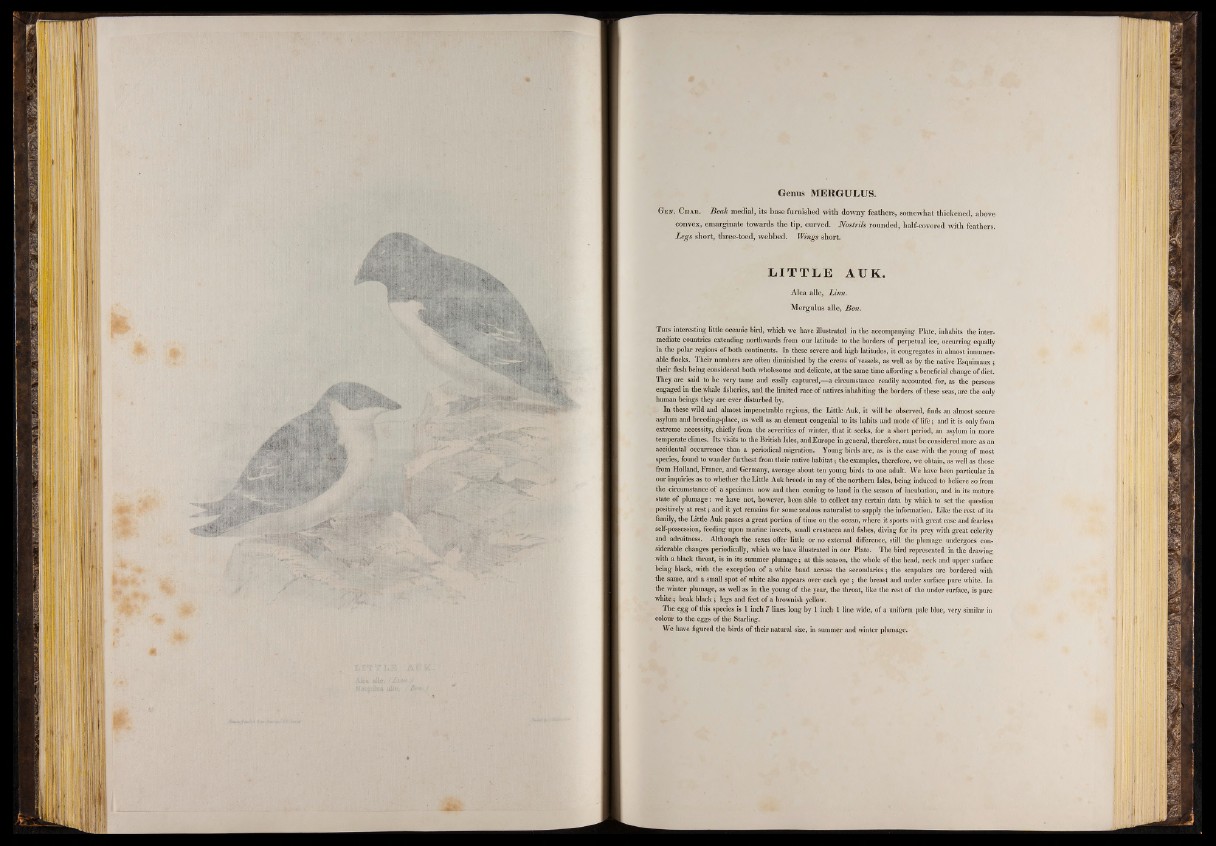
Genus MERGULUS.
Gen. C h a r . Beak medial, its base furnished with downy feathers, somewhat thickened, above
convex, emarginate towards the tip, curved. Nostrils rounded, half-covered with feathers.
Legs short, three-toed, webbed. Wings short.
L I T T L E AUK.
Alca alie, Linn.
Mergulus alle, Bon.
T his interesting little oceanic bird, which we have illustrated in the accompanying Plate, inhabits the intermediate
countries extending northwards from our latitude to the borders of perpetual ice, occurring equally
in the polar regions of both continents. In these severe and high latitudes, it congregates in almost innumerable
flocks. Their numbers are often diminished by the crews of vessels, as well as by the native Esquimaux;
their flesh being considered both wholesome and delicate, at the same time affording a beneficial change o f diet.
They are said to be very tame and easily captured,— a circumstance readily accounted for, as the persons
engaged in the whale fisheries, and the limited race of natives inhabiting the borders of these seas, are the only
human beings they are ever disturbed by.
In these wild and almost impenetrable regions, the Little Auk, it will be observed, finds an almost secure
asylum and breeding-place, as well as an element congenial to its habits and mode of life; and it is only from
extreme necessity, chiefly from the severities of winter, that it seeks, for a short period, an asylum in more
temperate climes. Its visits to the British Isles, and Europe in general, therefore, must be considered more as an
accidental occurrence than a periodical migration. Young birds are, as is the case with the young of most
species, found to wander furthest from their native habitat; the examples, therefore, we obtain, as well as those
from Holland, France, and Germany, average about ten young birds to one adult. We have been particular in
our inquiries as to whether the Little Auk breeds in any of the northern Isles, being induced to believe so from
the circumstance of a specimen now and then coming to hand in the season of incubation, and in its mature
state o f plumage: we have not, however, been able to collect any certain data by which to set the question
positively at rest; and it yet remains for some zealous naturalist to supply the information. Like the rest of its
family, the Little Auk passes a great portion of time on the ocean, where it sports with great ease and fearless
self-possession, feeding upon marine insects, small Crustacea and fishes, diving for its prey with great celerity
and adroitness. Although the sexes offer little or no external difference, still the plumage undergoes considerable
changes periodically, which we have illustrated in our Plate. The bird represented in the drawing
with a black throat, is in its summer plumage; at this season, the whole of the head, neck and upper surface
being black, with the exception of a white band across the secondaries; the scapulars are bordered with
the same, and a small spot of white also appears over each ey e; the breast and under surface pure white. In
the winter plumage, as well as in the young of the year, the throat, like the rest of the under surface, is pure
white; beak black; legs and feet o f a brownish yellow.
The egg of this species is 1 inch 7 lines long by 1 inch 1 line wide, of a uniform pale blue, very similar in
colour to the eggs of the Starling.
We have figured the birds of their natural size, in summer and winter plumage.